The numbers are striking - just 11% of podcast creators make video content today. This seems remarkably low since YouTube has become the biggest platform for podcasts with over 30 million people tuning in daily.
Video podcasts became more popular during the pandemic with 132 million viewers in the US expected by 2022. Visual content helps creators build a stronger connection with their audience and rank better in search results. That’s why video podcasts are a must have for modern content creators.
If you want to grow your audience, you can tap into multiple revenue streams through video. Sponsorships, affiliate marketing and digital products are new opportunities. This article will show you everything you need to get started and succeed with video podcasting. You’ll learn about the gear and proven ways to create visual content.
What is Video Podcasting and Why Should You Start?
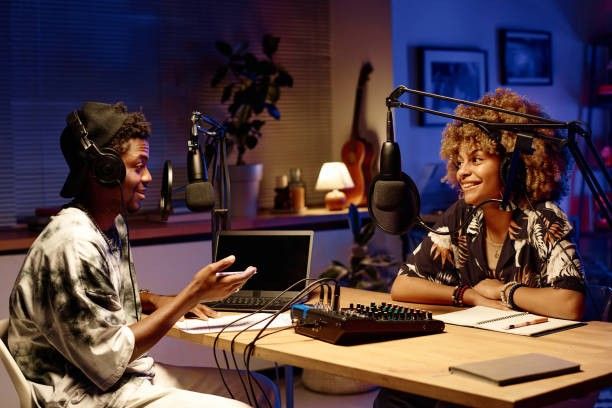
Video podcasting is a mix of traditional audio podcasting with visual elements. Unlike regular podcasts, video podcasts allow viewers to see facial expressions, body language and demonstrations. This helps podcasters build a deeper connection with their audience. Studies show people remember 95% of a message when they watch it on video compared to 10% when reading.
With video making up 82% of internet traffic, podcasting with video is a great way to grow an audience. Platforms like YouTube, Spotify and Apple Podcasts give video podcasters more exposure, making it easier to attract viewers and listeners. YouTube is the second largest search engine, so video podcasting can improve search rankings and increase discoverability.
Video podcasts also help content creators earn money through ad revenue, sponsorships and merchandise sales. YouTube’s monetization options include channel memberships, super chats and premium ads, so there are multiple revenue streams. Short video clips from podcasts can be repurposed for TikTok, Instagram Reels and other social media platforms to expand reach.
What Makes a Podcast a Video Podcast?
A video podcast, or vodcast, is a podcast that has visual elements. The level of video integration can vary. Some video podcasts use static images alongside audio, while others include fully produced video recordings of hosts and guests. The human brain dedicates 30% of its processing power to visual information so video podcasts work especially well when sharing information.
The four types of video podcasts are:
- Static image with audio: The simplest format where a single image remains on screen while the podcast plays.
- Studio recordings: A professionally filmed session in a dedicated recording space.
- Remote interviews: A format where hosts and guests connect via video conferencing.
- Mixed content: A combination of interviews, B-roll footage and additional visual elements.
Video podcasts require extra equipment like cameras, lighting and recording spaces making production more complex than traditional audio podcasts. Platforms like YouTube, Spotify, and Apple Podcasts support video content so podcasters have more ways to reach their audience.
The Growing Popularity of Video Podcasts
Video podcasting is growing quickly. Spotify reports that 170 million users watch video podcasts. The number of video podcasts on Spotify has gone from 100,000 in 2023 to over 250,000 today. In the US, 1/3 of Spotify’s monthly users watch video podcasts, and global video podcast viewership has grown 40% yearly.
YouTube dominates the space with over 400 million hours of monthly podcast listening on TV screens. The platform now accounts for 10.4% of all TV viewing time, surpassing major networks like Disney and NBCUniversal.
Different countries show different levels of video podcast adoption. In Chile, video podcasts make up 25% of all podcast hours, in Brazil, 15%, and in Brazil and the Philippines, 20% of podcast creators publish video content.
Gen Z is the key audience for video podcasts. Research shows 47% of Gen Z in the US consume podcasts monthly, a 57% increase from 2018. Many creators are using TikTok and Instagram Reels to reach a younger audience and 81% of weekly podcast listeners now watch video podcast content.
Benefits of Podcasting with Video
Video podcasting has several advantages over audio only formats.
Video podcasting has several advantages over audio only formats.
- Increased engagement and audience retention: Visual content keeps viewers engaged for longer. Seeing a speaker’s facial expressions and body language builds a stronger connection and makes content more memorable.
- Building a stronger brand connection: Video content humanizes podcast hosts, helps to establish trust and loyalty. Live Q&A sessions, audience polls and real-time interactions create a sense of community.
- Cross-promotion on video platforms: YouTube, TikTok and Instagram Reels provide extra exposure for video podcasts. Short clips from podcast episodes can be repurposed into highlight reels, teasers and promotional content to expand reach and drive traffic to full episodes.
Getting Started with Video Podcasting
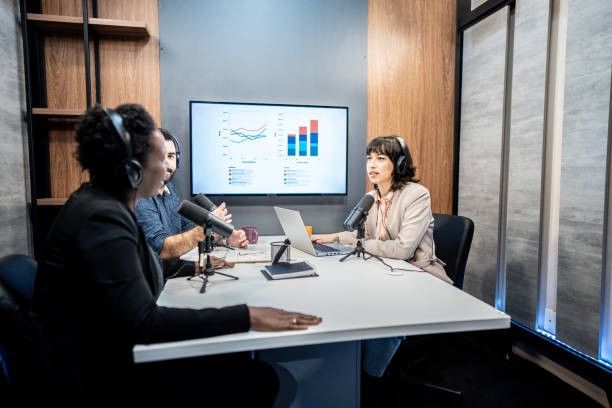
Video podcast creation requires you to consider both necessity and equipment. The technical aspects come later. First, decide if video fits your content strategy and audience priorities.
Do You Need Video for Your Podcast?
Several factors influence whether to add video to your podcast. While video increases audience engagement and monetization opportunities, it requires extra resources for production and editing.
Some key considerations are audience engagement, content type, resources and distribution goals. Podcasts that require visual demonstrations or educational content benefit greatly from video. However, creators with limited budget or time constraints may prefer to stick with audio only formats.
Many successful podcasters release both video and audio versions to maximize reach. Dual format approach caters to different audience preferences and makes content more accessible and flexible.
What Equipment Do You Need for Video Podcasting?
Creating a high quality video podcast requires some essential equipment, cameras, lighting and audio gear.
Cameras for Video Podcasting
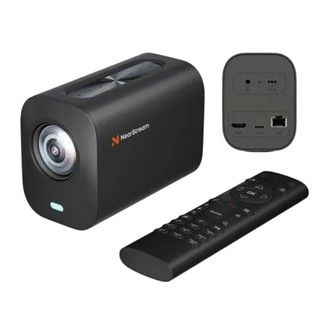
A good camera is the backbone of a professional video podcast. While smartphones like the iPhone 11 Pro can record in 4K, DSLR and mirrorless cameras provide better video quality. The DSLR Quality Optical Streaming Camera is a great choice for video podcasting, it provides crisp video for streaming and recording.
Another great option is the 10X Optical Zoom Wireless Streaming Camera, it delivers professional quality footage for remote interviews and panel discussions.
Lighting and Backdrops
Proper lighting is key to a professional looking video podcast. A three-point lighting setup works best, using a key light, fill light and backlight to eliminate shadows and enhance video quality. Choose a clean and visually appealing backdrop to improve production value.
Audio Equipment and Mic Recommendations
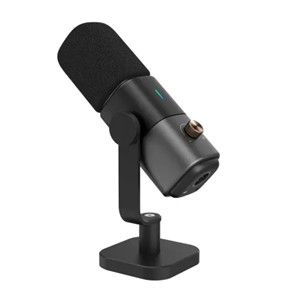
Audio quality is as important as video. A bad audio experience can drive viewers away so investing in a good microphone is crucial. The USB microphone for streaming and podcasting provides clear and professional sound.
For podcasters who need a complete setup, the Portable Audio Mixer and USB & XLR Condenser Microphone are great options for recording interviews and panel discussions. Wireless microphones like the AWM20T provide flexibility for dynamic podcast settings.
Setting Up a Video Podcast Studio
A professional video podcast needs the right studio setup. The physical space enhances both audio and visual elements that create an immersive experience for your viewers.
Choosing the Space
You need a dedicated recording area with the right room dimensions and acoustics. The space should be at least 10x12 feet to fit your equipment and give you room to move. Rooms with carpet and fewer windows will reduce unwanted sound reflections. The recording setup works best when it's placed away from walls to reduce audio bounce-back.
Lighting for Optimal Video Quality
Lighting plays a big role in video quality. A three-point lighting setup is ideal. The key light is the main light positioned at eye level and placed at a 45-degree angle. The fill light is placed opposite the key light and should be dimmed to soften shadows.
The backlight is placed behind the subject to create depth and make them stand out from the background. Keep the light color temperature between 5000K and 6500K for a natural and balanced look. Test the lighting setup before recording to adjust brightness and shadows.
Soundproofing Tips for Audio and Video
Sound treatment minimizes background noise and enhances audio clarity. Acoustic foam panels, mass-loaded vinyl and rugs help absorb sound reflections. Sealing gaps around doors and windows further prevents external noise interference. Investing in a good portable audio mixer like NearStream’s AMIX40U improves sound control and mixing.
Check and adjust both lighting and sound regularly. Test recordings should be made under different conditions to identify and fix issues before the final production.
Best Practices for Video Podcasting
Creating a great video podcast involves choosing the right format, using engaging visuals, editing effectively and selecting the right platform for distribution. These steps improve content quality, attract viewers and keep the audience engaged.
1) Choose the Right Format for Your Video Podcast
The format of your video podcast is key to its success. Common formats are solo commentary, interviews and panel discussions. Solo commentary works well for educational content and personal storytelling, interviews bring fresh perspectives and panel discussions encourage dynamic conversations among multiple participants. Choosing the right format depends on the content goals and the audience expectations.
2) Crafting Engaging Visual Content
Visuals make a podcast more immersive. Graphics, screen sharing and B-roll footage help explain complex topics. Text overlays highlight key points, show speaker names and present statistics to enhance retention.
High quality visuals, multiple camera angles and a consistent brand look engage viewers. The lighting is good, the backdrops are well thought out, and the smooth transitions look professional. Adding subtitles and captions increases accessibility and engagement, especially on platforms where users watch on mute.
3) Editing for Flow and Professionalism
Professional editing polishes raw footage into a finished product. Color grading enhances visual appeal, while transitions, wide shots and close-ups keep viewers interested. Tools like DaVinci Resolve, Adobe Premiere Pro and Final Cut Pro offer advanced editing options, while beginner-friendly tools like iMovie and AI-powered platforms like Riverside and Descript simplify the process. Well designed thumbnails with clear titles and visuals boost click-through rates.
4) Hosting and Distribution
Where to Host and Distribute Your Video Podcast? Choose the right platform to reach more and engage more. Hosting services like Libsyn, Podbean and CoHost offer full support with analytics and storage. YouTube is the leading video podcast platform. It offers more visibility, audience growth and monetization options. Other options like Vimeo, Wistia and Brightcove cater to different needs, ad-free streaming, enterprise solutions and marketing tools.
By choosing the right format, enhancing visuals, editing professionally and distributing effectively, you can maximize your video podcast and build an audience.
How to Set Up Your First Video Podcast(VM20 Streaming Camera
Setting up your first video podcast is an exciting journey and using a reliable streaming camera like the VM20 can help you produce great content. To create a successful video podcast, you need to plan, record, edit and promote it well.
Step 1: Plan Your Content and Audience

Before you start recording, you need to define your podcast’s niche and topic. Think about what you want to cover and how your podcast can provide value to your audience. Research shows that podcasts with specific target demographics get higher engagement rates. You should outline 2-3 episodes before going live. This buffer helps you maintain consistency. Whether your podcast is about technology, business, entertainment or education, consistency is key to building an engaged audience.
Your audience connection will improve when you create detailed listener personas that include:* Demographics (age, location, occupation)
- Content priorities and how they consume content
- Problems your podcast will solve
- Their favorite platforms and viewing habits
Step 2: Record and Edit Your Video Podcast
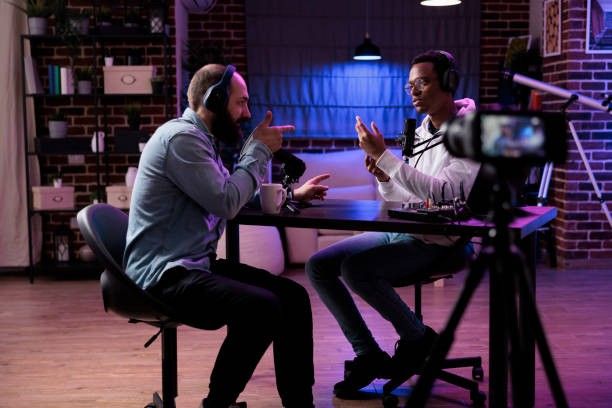
Once you have your plan ready, it’s time to record. The VM20 Streaming Camera gives you great video, but setup is key. Position the camera at eye level for a natural look and good lighting—use softbox lights if needed. Keep the background clean and professional to enhance the presentation. Audio quality matters too. Use an external microphone for clear sound and reduce background noise. If recording remotely, guide guests on proper camera, lighting and microphone setup.
After recording, edit your podcast to improve:
- Trim unnecessary parts (pauses, mistakes).
- Adjust audio levels and remove background noise.
- Add captions for accessibility.
- Use transitions, branding and multiple angles for a polished look.
Editing tools like Adobe Premiere Pro, Final Cut Pro or Riverside make the process easier, making your podcast more professional and engaging.
Step 3: Publish and Promote Your Video Podcast
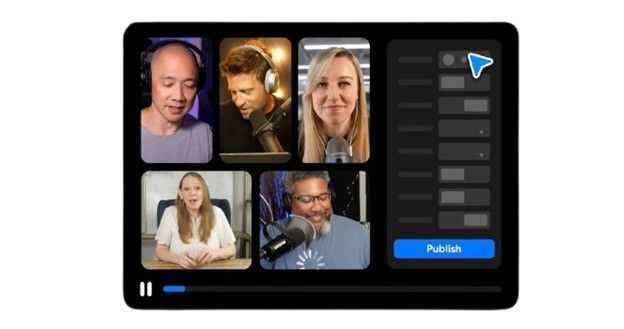
Your content needs to be on multiple platforms. The best approach is to upload on major platforms like YouTube, Spotify and Apple Podcasts. YouTube is key for video podcasts. Statistics show 94% of monthly podcast listeners are active on social media platforms. Engage with your audience by responding to comments and promote your podcast through email newsletters and live Q&A sessions.
Your visibility will grow when you:
- Make short, shareable clips for social media
- Design eye-catching thumbnails with podcast logos and episode titles
- Write detailed descriptions with relevant keywords
- Respond regularly to audience comments and feedback
Collaborating with other content creators in your niche works well. This helps you reach established audiences and builds your credibility in your target community.
Follow these simple steps and you’ll create and grow a successful video podcast with the VM20 Streaming Camera. Improve, stay consistent and connect with your audience to build your brand.
Video Podcasts to Inspire You
Learning from successful video podcasts gives creators great ideas. The best shows demonstrate powerful ways to blend visual and audio elements to keep audiences hooked.
Entrepreneur Video Podcasts
The Tim Ferriss Show is one of the top downloaded podcasts and features in-depth conversations with industry leaders. Harvard Business Review’s IdeaCast stands out with its visual presentation on LinkedIn where business professionals engage with the content.
Video Podcasts to Watch for Content Inspiration
Watching podcasts in your niche helps you stay up to date and inspired. Whether you’re in tech, marketing or fitness, find top podcasts that offer expert insights and trends.
Diana Gladney’s Video Simplified shows technical excellence. She breaks down everything from camera settings to storytelling and makes complex topics accessible. Colin and Samir’s show delivers weekly updates on Spotify and YouTube about content creation trends.
SiriusXM’s $125 million acquisition of Call Her Daddy showcases professional set design with two unique studio setups—one for interviews and another for solo conversations. The Basement Yard’s raw editing style matches the show’s personality. Their success shows in their 840,000 YouTube subscribers and 4.3 million TikTok followers.
What Makes a Great Video Podcast?
A great video podcast stands out through technical excellence, engaging content and a strong visual identity. High quality production starts with HD video capture, clean framing and professional audio from condenser microphones. A well planned lighting setup enhances the presentation.
Content quality keeps viewers engaged. Research shows that 57% of business-related YouTube videos are watched daily or weekly. Successful shows keep interest by following a clear episode structure with defined goals, mixing interviews and monologues, and using graphics and text overlays.
A professional visual identity helps establish a strong brand presence. Consistency in color schemes, typography, and eye-catching thumbnails featuring expressive faces make a podcast more recognizable. Brand elements further strengthen the identity and create a memorable impression.
Key metrics like average watch time, interaction rates and platform performance indicators measure success. Creators use this information to improve and boost engagement.
Beginners: Video Podcasting for New Creators
Starting a video podcast doesn’t have to be daunting. The right mindset and simple tools help new creators build a strong foundation for their show.
1) Start Simple: You Don’t Need Expensive Equipment
Modern smartphones have great cameras that capture high quality video, often better than some budget cameras. For audio, a quality USB microphone makes a big difference. The Fifine (around $35) or Samson Q2U (about $70) are great affordable options.
Editing doesn’t have to be complicated or expensive. Free tools help polish both audio and video without breaking the bank:
- Audacity is good for audio editing on Windows.
- GarageBand works for Mac users.
- DaVinci Resolve is a professional-grade video editing software with no cost.
These tools help refine your content and improve the overall quality of your video podcast.
2) Overcoming Video Podcasting Challenges
Recording sessions often face technical issues. A pre-recording checklist helps you avoid common problems:
- Test all equipment before each session
- Keep backup batteries and cables handy
- Record in a controlled environment
Small precautions help ensure a smooth recording experience and reduce stress during production.
Many podcasters initially feel nervous on camera, but practice makes a huge difference. A great way to improve is by recording test sessions with a small team or even by yourself. Watching your own recordings helps you identify areas for improvement, whether it’s body language, voice tone or pacing. The more you practice, the more natural and confident you’ll feel over time.
How to Grow Your Video Podcast Audience?
Social media platforms drive podcast growth powerfully. Video clips work exceptionally well - social videos get shared 1,200% more than text and images combined.
These promotion strategies work best:
- Share episode clips
- Create platform-specific content
- Use relevant hashtags
Collaborations help you expand your reach significantly. Look for podcast partners who align with your audience interests but reach different demographics. This way you tap into new listener groups and keep content relevant.
Cross promotion goes beyond traditional podcasting. Guest blogging, joint social media campaigns and collaborative mini-series help you boost visibility across platforms. Podcast networks and guest matching services connect you with potential collaborators and grow shared audiences.
Video Podcasting Trends to Follow
YouTube has become the go-to platform for podcast consumption and changed the media landscape. It is now America’s most popular podcast platform, reaching 31% of weekly podcast listeners.
The Future of Video Podcasts
Video podcasting is moving fast with major platforms like YouTube, Spotify and Apple Podcasts leading the charge. Interactive features like polls and real-time feedback have turned passive listening into a two-way conversation. AI powered recommendations, AR and VR are also shaping the future offering personalized and immersive experiences for viewers.
Live Streaming is another game changer making podcasts more dynamic and interactive. Edison Research says 81% of weekly podcast listeners now watch video podcasts, so the shift to visual content is clear. Platforms are investing in video-driven features. YouTube users consume over 400 million hours of podcasts a month and Spotify has 250 million users with video podcasts.
Social media is also key to podcast growth. Many podcasts have millions of followers on platforms like TikTok and are reaching beyond their traditional audience. With ad revenue expected to double by 2025, video podcasting will be the future of digital media.
Conclusion: Master Video Podcasting
Video podcasting is now part of content creation, giving creators new ways to connect with their audience. With platforms' support and audience interest growing, visual content is more popular than ever.
Success in video podcasting depends on setup, good content and audience engagement. Creators who focus on these will build their presence across multiple platforms. Beginners can start with simple equipment but delivering valuable content should be the main focus. Over time, professional tools and resources like nearstream.us can help improve production quality and make the process smoother.
Video podcasting is evolving with interactive features, live streaming and better ways to connect with the audience. Content creators who adopt these and build genuine relationships with their viewers will succeed in this medium.



































































